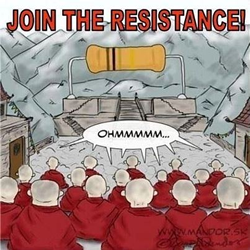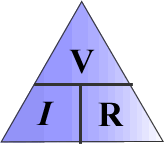Factors
that affect the resistance of a wire
The resistance of
an object is a measure of the how reluctant current is to flow through
that object. It is given the symbol R and has the unit W (which is a greek letter omega and pronounced 'ohm')
Current only flows
through a component of a circuit if a potential difference (voltage) is
put across it. The bigger the potential difference across its ends the
bigger the current flow. This is because there is a steeper 'electric
slope' in place to make the charges slide down... steeper slope - faster
slide!
The equation below
is used to work out the resistance of a component from measurements of
the current flowing through it and the potential difference across its
ends. |
 |
Can
you sketch a circuit diagram of a suitable circuit you could use to find
out such information?
You should be able to!
V = I R
Where
V = potential difference in volts (V)
I =
current in amps (A) and
R =
resistance in ohms ( ) ) |
 |
Current is the rate
of flow of charge. The charge flowing in a wire is carried by the electrons
that orbit the atoms that make up the wire. As soon as a potential difference
is applied the electrons generally drift in one direction (you can think
of it as rolling down a slope). The bigger the p.d. the faster their average
speed and the more charge will move past a point in a second - bigger
current!
Increasing the number
of electrons experiencing 'the slope' will mean more flow past a point in
a second and so more charge passes a point in a second and more current
flows.
There are four
factors that affect the resistance of a wire:
 Resistance is
proportional to length. If you take a wire of different lengths
and give each a particular potential difference across its ends. The
longer the wire the less volts each centimetre of it will get. This
means that the 'electric slope' that makes the electrons move gets
less steep as the wire gets longer, and the average drift velocity
of electrons decreases. The correct term for this 'electric slope'
is the potential gradient. A smaller potential gradient (less volts
per metre) means current decreases with increased length and resistance
increases.
Resistance is
proportional to length. If you take a wire of different lengths
and give each a particular potential difference across its ends. The
longer the wire the less volts each centimetre of it will get. This
means that the 'electric slope' that makes the electrons move gets
less steep as the wire gets longer, and the average drift velocity
of electrons decreases. The correct term for this 'electric slope'
is the potential gradient. A smaller potential gradient (less volts
per metre) means current decreases with increased length and resistance
increases.

 Resistance is
inversely proportional to cross-sectional-area. The bigger the
cross sectional area of the wire the greater the number of electrons
that experience the 'electric slope' from the potenetial difference.
As the length of the wire does not change each cm still gets the same
number of volts across it - the potential gradient does not change
and so the average drift velocity of individual elecrons does not
change. Although they do not move any faster there are more of them
moving so the total charge movement in a given time is greater and
current flow increases. This means resistance decreases. This does
not give rise to a straight line graph as cross sectional area is
inversely proportional to resistance not directly proportional to
it.
Resistance is
inversely proportional to cross-sectional-area. The bigger the
cross sectional area of the wire the greater the number of electrons
that experience the 'electric slope' from the potenetial difference.
As the length of the wire does not change each cm still gets the same
number of volts across it - the potential gradient does not change
and so the average drift velocity of individual elecrons does not
change. Although they do not move any faster there are more of them
moving so the total charge movement in a given time is greater and
current flow increases. This means resistance decreases. This does
not give rise to a straight line graph as cross sectional area is
inversely proportional to resistance not directly proportional to
it.

Physicists
like to get straight line relationships if they can.... can you think
of a way of getting a straight line graph through the origin? What would
you have to plot?
 Resistance depends
on the material the wire is made of. The more tightly an atom
holds on to its outermost electrons the harder it will be to make
a current flow. The electronic configuration of an atom determines
how willing the atom will be to allow an electron to leave and wander
through the lattice. If a shell is almost full the atom is reluctant
to let its electrons wander and the material it is in is an insulator.
If the outermost shell (or sub-shell with transition metals) is less
than half full then the atom is willing to let those electrons wander
and the material is a conductor.
Resistance depends
on the material the wire is made of. The more tightly an atom
holds on to its outermost electrons the harder it will be to make
a current flow. The electronic configuration of an atom determines
how willing the atom will be to allow an electron to leave and wander
through the lattice. If a shell is almost full the atom is reluctant
to let its electrons wander and the material it is in is an insulator.
If the outermost shell (or sub-shell with transition metals) is less
than half full then the atom is willing to let those electrons wander
and the material is a conductor.
A
graph for this would be a bar chart not a line graph.
 Resistance
increases with the temperature of the wire. The hotter wire has
a larger resistance because of increased vibration of the atomic lattice.
When a material gets hotter the atoms in the lattice vibrate more.
This makes it difficult for the electrons to move without interaction
with an atom and increases resistance. The relationship between resistance
and temperature is not a simple one.
Resistance
increases with the temperature of the wire. The hotter wire has
a larger resistance because of increased vibration of the atomic lattice.
When a material gets hotter the atoms in the lattice vibrate more.
This makes it difficult for the electrons to move without interaction
with an atom and increases resistance. The relationship between resistance
and temperature is not a simple one.

( (alpha)
is the thermal resistance coefficient)
(alpha)
is the thermal resistance coefficient)
-------------------------------------------
At A level we will
put these equations into an equation. Check
out the page and read a little further.....










